Robin Hood posts
Tuesday May 18, 2010
Armond White's Review of “Robin Hood” —with Footnotes
Every Man for Himself
Russell Crowe plays Ridley Scott’s everyman again—this time with arrows
By Armond White
At a reported cost of over $200 million, according to the London Telegraph, Ridley Scott’s Robin Hood refutes the old altruistic axiom “rob from the rich and give to the poor.” All the charm and meaning has been taken out of this reboot. It’s now a “history,” opening with a detailed inscription to establish the 12th-century tale’s seriousness: “In times of tyranny and injustice, where law oppresses the people, the rebel takes his place in history.” In other words, Gladiator II.
I assumed the title card was an homage to earlier cinematic version of “Robin Hood” rather than a call to seriousness. Who knows? But every major “Robin Hood” movie has begun with such a description.
Russell Crowe once again plays Scott’s everyman hero who rises above his taciturn machismo to avenge dreadful memories—clever shtick for the wealthy duo that like to pretend they’re doing something besides just raking it in.
Question: how is this not a potential criticism of any movie in which a star plays an everyman? Movie stars are wealthy; everymen are not. Was it shtick for Crowe to play an everyman hero in “L.A. Confidential”? And what’s the point of guessing at the motivations of Crowe and Scott? What does that have to with what’s on the screen?
Their nouveau-riche narcissism imagines having a populist purpose, yet the clichés of Robin Longstride’s archery skills, put to use in the English army’s campaign against the French while, back home, Marian Locksley (ludicrous Cate Blanchett) tills her impoverished, overtaxed fields, don’t speak for the people, except in distant, almost invisible metaphor.
I had to read this sentence several times to fathom its meaning... and I still don’t quite fathom its meaning: “...the clichés of Robin Longstride’s archery skills....don’t speak for the people...”? WTF? In general, White seems to be saying that the film pretends to be populist but isn’t. Maybe: It’s the one Robin Hood movie in which King John and Robin Hood fight side-by-side. On the other hand: It’s the only Robin Hood movie where Robin is a commoner, where none of the royals, including Richard, are particularly worthy, and where the end game is not the return of King Richard (and a more benevolent monarchy) but the adoption of the Magna Carta (and the beginning of liberty for all). Some might consider this a populist message.
And the motto these oppressed Brits live by (“Arise and arise until lambs become lions”) isn’t about Tea Party insurrection; it merely replaces poetic generosity with vengeance.
Does White want the motto to reflect Tea Party insurrection? Admittedly “Rise and Rise Again” is an odd slogan for this movie, since Crowe as Robin is always a lion, and so doesn’t need to rise and rise again to become one. But it works if one thinks of the Magna Carta as the end game. We all must rise again until we stop being sheep and become men.
Scott and Crowe return to Gladiator’s violent formula because the high-life confessions of their “A Good Year” collaboration didn’t click. But they also seem to be chasing after Antoine Fuqua (the director Scott replaced on American Gangster) in the way Robin Hood repeats the insipid realism of Fuqua’s 2004 King Arthur, the grungy, anti-poetic reboot of Arthurian tales. Both films represent a dullard’s version of history; Hollywood’s commercial calculation has become so obvious that it removes beauty from storytelling. Screenwriter Brian Helgeland’s period setting over-simplifies the context for violence—reusing his Braveheart formula but without director-star Mel Gibson’s conviction.
Why would they be chasing after Fuqua—“King Arthur” failed miserably. And what exactly is the commercial calculation in removing beauty from storytelling? Let’s face it, there’s not much in the plot here that is commercial. It is, in fact, the least commercial of all the Robin Hood movies since it never even gives us Robin Hood.
Look at Scott’s superficial “beauty”: a couple of dusk landscapes (amazingly subtle lighting by John Mathieson) and a splendid view of French ships roiling on blue, misty waves. But these are not “cinematic” images; they’re mini TV commercials that lack existential vision. Ultra-hack Scott reverts to the slickness of his advertising background. TV imagery has pervaded cinema to the point that Scott doesn’t balance his over-cropped TV-style close-ups with the postcard vistas. Like Gladiator’s jarring F/X, it shows Scott’s disrespect for cinema.
White piles insults upon opinions here. It’s all air. There’s nothing to even push against.
Fake beauty and fake history rob Robin Hood of previous moral value. It’s no longer “legendary” because Scott and Helgeland’s sham realism trivializes history. They pretend how history happened (Monty Python-style) but their embarrassing, anachronistic rip-off of Saving Private Ryan’s beachfront battle scene shows no feeling for how history is constructed and passed down through ritual, repetition and affection. An abstract end-credits sequence is more imaginative (it’s in the style of Scott’s Scott Free company logo). In place of inspiration, Robin Hood has the bloat of a 1960s roadshow presentation: Costly, overlong but with no intermission—or reprieve.
The previous moral value of Robin Hood stories has been greatly exaggerated. In older stories, Robin is basically a noble fighting a disreputable royal until a better, war-mongering royal returns, so life can continue as is. This Robin is using his luck to actually push for reform. I’m not saying Scott’s “Robin Hood” is a good movie. I’m saying White, in his ad hominem attacks, doesn’t delineate any of the reasons why it’s not good.

Back in '38, when, according to White, “Robin Hood” had a true populist message: to fight and bow before a benevolent, warmongering monarch like King Richard the Lionheart (Ian Hunter, above).
Sunday May 16, 2010
Robin Hood — Libertarian?
Here's my favorite part of A.O. Scott's review of the new “Robin Hood”:
Meanwhile — and believe me, there is a whole lot of meanwhile in this crowded, lumbering film —...
Here's my least-favorite part:
You may have heard that Robin Hood stole from the rich and gave to the poor, but that was just liberal media propaganda. This Robin is no socialist bandit practicing freelance wealth redistribution, but rather a manly libertarian rebel striking out against high taxes and a big government scheme to trample the ancient liberties of property owners and provincial nobles. Don’t tread on him!
Yes, Robin Hood, in legend, is most famous for robbing from the rich and giving to the poor, but Hollywood, liberal Hollywood, has never followed suit. In the Fairbanks version in 1922, Robin and his men sing about it (“We rob the rich, relieve distressed...”), and an arrow quivers close to “the Rich Man of Wakefield,” but that's about it. Otherwise they're against Prince John's excessive taxes. The Flynn version during the Depression? That caravan they rob is full of Prince John's tax money. Costner? He does rob a wealthy man, and takes the necklace off of his comely daughter, but he, too, is mostly about getting back tax money. Ditto Patrick Bergin the same year. You can take issue with it, but don't pretend it's anything new. Hollywood always makes it personal, not political.
Plus the libertarian line is just silly. The libertarian assumption is that we're all free and government enslaves us. The 12th century assumption is that we're all enslaved, at the whim of a king who is chosen by God, so Robin tries to use government, i.e., kingly decree, to free us. We're talking different planets.
Most important, and please accept the usual SPOILERS here, the fault of the new “Robin Hood” movie isn't that Robin Hood does't rob from the rich and give to the poor; it's that he never becomes Robin Hood.
Ah, well. At least Scott's review isn't as bad as Armond White's.
Friday May 14, 2010
From the Old Man
 “As long as you're grading all the Robin Hood movies by category, don't forget the score. The Errol Flynn version had, to my mind, the best movie score ever written. It was written by Erich Korngold, the greatest musical prodigy since Mozart, who emigrated to Hollywood from Hitler's Germany and didn't do much except write a hauntingly lovely violin concerto.”
“As long as you're grading all the Robin Hood movies by category, don't forget the score. The Errol Flynn version had, to my mind, the best movie score ever written. It was written by Erich Korngold, the greatest musical prodigy since Mozart, who emigrated to Hollywood from Hitler's Germany and didn't do much except write a hauntingly lovely violin concerto.”
—Bob Lundegaard, in an e-mail to his ne'er-do-well son, Wednesday.
Thursday May 13, 2010
Everything You Need to Know About Robin Hood... *
* ...but didn't ask. Review of the new movie will be up Saturday. Hopefully.
What’s Robin’s official name/title?
- 1922: The Earl of Huntingdon
- 1938: Sir Robin of Locksley
- 1976: Robin
- 1991 (GB): Sir Robert Hode, Earl of Huntingdon
- 1991 (US): Sir Robin of Locksley
- 2006 (BBC): Robin, Earl of Huntingdon, in the first episode. Sir Robin of Loxley when he marries Marian in the second season.
- 2010: Robin Longstride
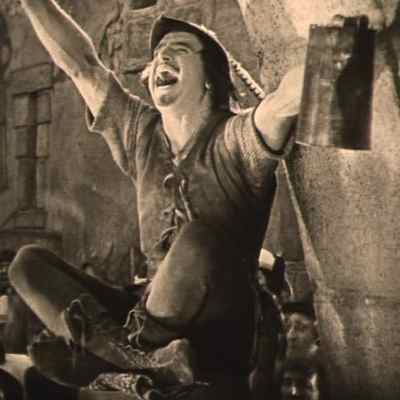

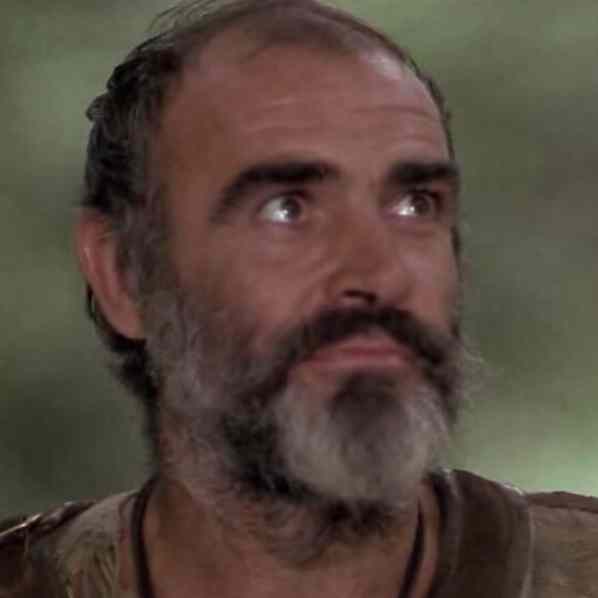




Many faces. Fewer hats and feathers.
Who is his right-hand man?
- 1922: John Little
- 1938: Will Scarlett
- 1976: John Little
- 1991 (GB): Will Scarlett
- 1991 (US): Azeem, the Moor
- 2006 (BBC): Much, the Miller’s Son
- 2010: He doesn't really have one
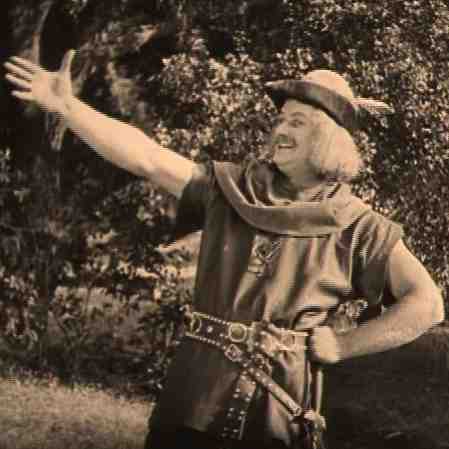
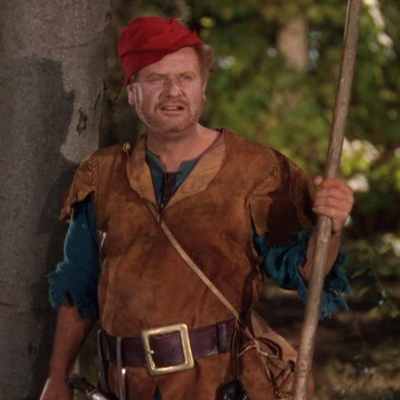
Alan Hale played Little John three times: in ‘22 and ’38 (above),
and in “The Rogues of Sherwood Forest” (1950), his final role.
Who’s Missing? (Or why Alan-a-Dale is the Rodney Dangerfield of the Merry Men)
- 1922: Much, the Miller’s Son
- 1938: Alan-a-Dale
- 1976: Alan-a-Dale; Guy of Gisbourne; and Much, the Miller’s Son
- 1991 (GB): Alan-a-Dale; and King Richard
- 1991 (US): Alan-a-Dale; and Prince John
- 2006 (BBC): No one. Yep, not even Alan-a-Dale.
- 2010: Guy of Gisbourne; and Much, the Miller’s Son. Which means we have our first cinematic Alan-a-Dale in 88 years! Welcome back.



The forgotten merry man, in 1922, 2006 and 2010.
Who's the main villain—Sir Guy of Gisbourne or the Sheriff of Nottingham?
- 1922: Sir Guy of Gisbourne, who tries to kill King Richard in the Holy Land and has his eye on Lady Marian Fitzwalter. The Sheriff of Nottingham is a walk-on.
- 1938: Sir Guy of Gisbourne, who duels memorably with Robin Hood in the end. The Sheriff of Nottingham, in comparison, is fat, cowardly, and used for comic relief.
- 1976: The Sheriff of Nottingham. There is no Sir Guy of Gisbourne in this version.
- 1991 (GB): Sir Miles Folcanet (basically Sir Guy of Gisbourne). Baron Daguerre (basically the Sheriff of Nottingham) helps unite Norman and Saxon in the end.
- 1991 (US): The Sheriff of Nottingham, who has his eye on the throne. His cousin, Guy of Gisbourne, battles Robin early and often but is killed by the Sheriff for a) failing to kill Robin, and b) getting robbed in Sherwood Forest.
- 2006 (BBC): The Sheriff of Nottingham. In the first season Sir Guy takes Robin’s lands, then tries to take Robin’s woman (and eventually kills her), but by the third season he actually joins the Merry Men. The Sheriff is always the bad guy and always the man with the real power.
- 2010: Godfrey. The Sheriff’s a joke. Sir Guy doesn’t exist. Yet.

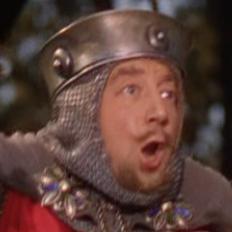


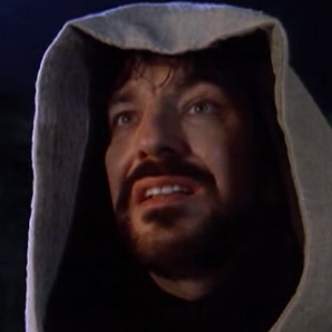
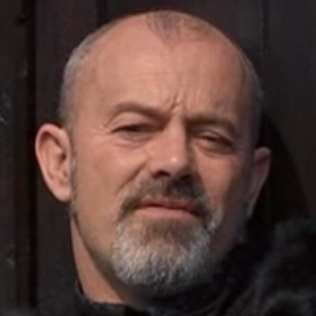
Six faces of the Sheriff of Nottingham: From walk-on in ‘22
to a man eyeing the throne of England in ’91.
How does Robin demonstrate his archery prowess?
- 1922: A piece of wood is tossed into the air and he shoots two arrows into it. Everyone else, at best, can only shoot one arrow into the wood.
- 1938: In the final round of an archery contest, Philip of Arras shoots a bullseye but Robin splits his arrow. As a child I thought: “Doesn’t that mean they tied?”
- 1976: In the end, posioned, he shoots an arrow out the window from his deathbed. Where it lands is where he’ll be buried.
- 1991 (GB): In a contest to prove his worth to a band of outlaws, their best archer, Harry, comes within inches of a piece of wood at 100 paces. Robin splits the wood.
- 1991 (US): He shoots a weapon out of Will Scarlett’s hand and splits a rope that is hanging one of his men. Also, in a nice touch, he run the feathers through his mouth before doing any shooting.
- 2006 (BBC): What doesn’t he do? He just doesn't kill anyone.
- 2010: He grazes the face of the fleeing Godfrey in France and later kills the fleeing Godfrey on British beaches with a distant, arced shot.

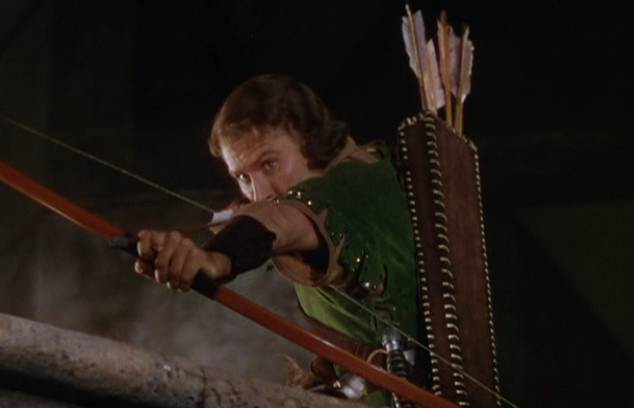

In what way does Robin rob from the rich and give to the poor?
- 1922: A poor boy gets coins. An arrow comes within a whisker of killing “The Rich Man of Wakefield.“ The Merry Men also sing a song (silently) about their feats:”We rob the rich, relieve distressed/ On damned John to score/ We’ll take a life if sorely pressed/ Till Richard reign once more.“ But that’s about it.
- 1938: Robin makes his men swear an oath “to despoil the rich, only to give to the poor,” but we don’t see much despoiling. They memorably rob the caravan, led by Sir Guy and the Sheriff, but that’s guv‘ment money.
- 1976: I’m not sure he does. When he returns to Sherwood 20 years later, he learns people are singing songs about him. “Everywhere we go, they want to hear the things that you did,” Will tells him. To which Robin replies, “We didn’t do them.”
- 1991 (GB): When the Baron raises taxes, Robin and his men steal the taxes. When the Baron raises the reward money on Robin’s head, Robin decides to give the tax money back to the people as a way to keep them on his side. “It’s their money anyway,” he says. Again, though, he’s mostly stealing taxes. The rich, wherever they are, are relatively safe.
- 1991 (US): Ditto. Although one rich man loses his purse and his comely daughter loses her necklace. Insert vice-versa joke here.
- 2006 (BBC): Yes, probably, but it’s mostly a battle between Robin and the Sheriff, with the usual TV fluff.
- 2010: He doesn‘t.
Why do Robin and his men storm the castle at the end?
- 1922: To rescue Marian.
- 1938: To prevent Prince John from declaring himself King of England. Also to rescue Marian.
- 1976: He doesn’t; the final battle takes place in a field next to Sherwood Forest.
- 1991 (GB): To rescue Marian from a forced marriage.
- 1991 (US): To save his men from a hanging and to rescue Marian from marriage/rape.
- 2006 (BBC): They actually storm out of the castle, leave the Sheriff in it, and blow the damned thing up. Nice touch.
- 2010: The castle, French, is stormed at the beginning.
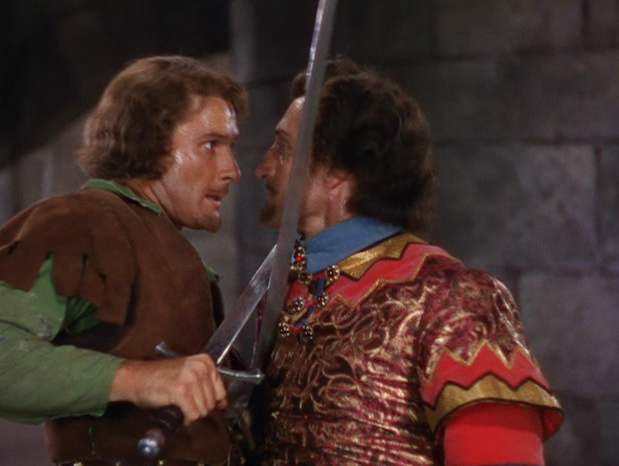
Guy: “Do you know any prayers, my friend?”
Robin: “I’ll say one for you!”
Who dies?
- 1922: Guy of Gisbourne (by Robin Hood)
- 1938: Guy of Gisbourne (by Robin Hood)
- 1976: Robin Hood (by Marian); the Sheriff of Nottingham (by Robin Hood); and King Richard (to madness and disease)
- 1991 (GB): Sir Miles Folcanet (by Robin Hood)
- 1991 (US): The Sheriff of Nottingham (by Robin Hood); and his mother (by Azeem the Moor)
- 2006 (BBC): Robin Hood (by Isabella, Guy’s sister); Maid Marian (by Guy of Gisbourne); Guy of Gisbourne (by the Sheriff of Nottingham); Alan-a-Dale (by the Sheriff of Nottingham); and the Sheriff of Nottingham (by Robin Hood). The thing’s got more deaths than Hamlet.
- 2010: King Richard (to a French arrow).

Final shot.
Tuesday May 11, 2010
Robin Hoods: How Holy are the Crusades?
1922 (Fairbanks):
Very! “In far-off Palestine,” a title card reads halfway through the film, “Richard meets with victory and concludes a truce with the infidel.” Afterwards we see Arabs marched through the streets while an English knight on horseback takes a lazy bite out of an apple. There’s never a sense that the Crusades are not a good idea.
1938 (Flynn):
Mixed. The opening titles trumpet the Crusades: “In the year of our Lord 1191 when Richard, the Lion-Heart, set forth to drive the infidels from the Holy Land...” But, reflecting American attitudes in 1938, we also get a strong isolationist bent, as Robin blames King Richard and the Crusades for the recent unpleasantness with Prince John, Sir Guy and the Sheriff: “His task was here at home defending his own people instead of diverting it to fight in foreign lands,” Robin says. Appropriately, this Robin is also the only one who doesn't go off to fight in the Crusades.
1976 (Connery):
Decidedly unholy. The crusades, reflecting post-Vietnam sensibilities, are a sad, dispirited affair, while King Richard, instead of being a great hero, is a near madman who kills women and children for, as Robin tells him, “a piece of gold that never was.” Robin relays the pointlessness of the Crusades to Marian back in Sherwood. She asks if he’s sick of the fighting and he responds: “On the 12th of July, 1191, the mighty fortress of Acre fell to Richard. His one great victory in the whole campaign. He was sick in bed and never struck a blow. On the 20th of August, John and I were standing on a plain outside the city, watching, while every Muslim left alive was marched out in chains. King Richard spared the richest for ransoming, took the strong for slaves, and he took the children, all the children, and had them chopped apart. When that was done he had the mothers killed. When they were all dead, 3,000 bodies on the plain, he had them all opened up, so their guts could be explored for gold and precious stones. Our churchmen on the scene—and there were many—took it for a triumph. One bishop put on his mitre and led us all in prayer. (Pause) And you ask me if I’m sick of it.”
1991 (Costner):
Unholy. Robin’s decision to join the Crusades severs him from his father, who is killed by the Sheriff of Nottingham in his absence. When Robin returns to his father’s grave, he says, “I should’ve been here. [Father] called the Crusades a foolish quest. Said it was vanity to force other men into our religion.” Later, in rallying his not-so-merry men, he declares, “One free man defending his home is more powerful than 10 hired soldiers. The Crusades taught me that.” Plus the wisest man in the entire movie is Robin's right-hand man, Azeem the Muslim (Morgan Freeman), whose telescope frightens Robin (“How did your uneducated kind ever take Jerusalem?” Azeem says), and who gives a better rallying speech than Robin ever does: “I am not one of you but I fight for you! I fight with Robin Hood!” In a perfect world he’d be the star. OK, he was the star.

2006 (BBC):
“Bloodthirsty.” That's how Robin reponds in the first episode when asked how the Holy Land is. Later he questions the whole enterprise: “Is it our holy war? Or is it Pope Gregory’s?” Turns out he’s developed a broad, 21st-century view of this narrow, 12th-century conflict. “You know why I went to war?” he says. “To recover Jerusalem, to recover our Holy Land. [But] when I got there I met the Muslims, I met the Jews. And I realized it was their Holy Land, too.” A Muslim girl, pretending to be a boy, Djac, joins the merry men for 22 out of 39 episodes. Like Azeem, she has a magnifying glass. Like Azeem, she’s rarely wrong. Like Azeem, she’s proud. In her first episode she refuses to renounce her God to save her skin: “Why would I pretend to be Christian?” she says. “You killed my people in the name of Christianity.” No one takes a lazy bite out of an apple.
2010 (Crowe):
Unholy. Early in the film, King Richard, sacking a French castle upon his return from the Crusades, walks disguised among his troops, searching, like Diogenes, for an honest man. He finds one in Robin Longstride and asks him: “What is your opinion of my Crusade? Will God be pleased with my gesture?” Robin pauses, then pauses, then says, “No, He won’t." Like Connery's Robin, this Robin talks about the massacre at Acre, about the killing of women and children. He talks about the look a Muslim woman gave him before he beheaded her. It wasn’t anger; it was pity. “She knew when you gave the order,” he says, “we would be Godless. All of us.”
Monday May 10, 2010
Robin Hoods: How Tough Is Maid Marian?
1922: Enid Bennett as Lady Marian Fitzwalter:
Not. She fakes suicide to escape the lecherous advances of Prince John, then hides in a neaby convent while waiting the return of Robin, Earl of Huntingdon. Later she’s kidnapped, and Robin storms the castle to save her. When all hope seems lost, he hands her a knife so she can kill herself rather than be dishonored by the lecherous advances of Guy of Gisbourne. She’s basically a pale, frail thing who veers between death and dishonour.
1938: Olivia de Havilland as Maid Marian:
Not much. Sure, she rides in the middle of the night to a Saxon pub and comes up with the plan that saves Robin from hanging. Otherwise she’s a very sweet Norman girl who starts out a bit prejudiced against the Saxons, then falls in love with a Saxon lord. Oh, and by the end she needs rescuing from a dungeon. Go figure.
1976: Audrey Hepburn as Lady Marian
This one’s tricky. In the beginning she gets punched in the face by Robin, then breaks down when telling him how much it hurt to lose him, so she seems a pushover. At the end she kills Robin with poison rather than lose him again, so she’s clearly not. Plus, for the first and only time, she gets equal billing. The movie’s called “Robin and Marian."
1991: Elizabeth Mastrantonio as Marian Dubois:
When we first see her she’s a masked figure who kicks Robin in the groin (always good for a laugh). By the end she’s nearly raped by the Sheriff of Nottingham (which the movie, with its tin ear, plays for laughs). She starts out tough then winds up weak and in need of rescuing—the opposite of Audrey’s arc.
1991: Uma Thurman as Maid Marian:
Not only does she staunchly refuse the hand of Sir Miles Folcanet (basically: Sir Guy of Gisbourne), but she pretends to be a boy to infiltrate Robin’s band. (Since this is Uma, that’s one helluva wrap job.) In the end, she is forced to go along with the wedding but is saved by Robin, whose forces she joins in battling Sir Miles. She swings down on a rope and takes out three knights like they‘re bowling pins.
2006: Lucy Griffiths as Marian:
She’s not just Marian, the girl fought over by Robin of Locksley and Sir Guy of Gisbourne; she’s also The Night Watchman, the masked avenger whose exploits around Nottingham predate Robin’s. So not only does she not need rescuing, thank you very much, she’s actually the world’s first masked superhero.
2010: Cate Blanchett as Marion Loxley:
Legally, she doesn’t have many rights. Her husband dies and his father, Sir Walter Loxley, tells the messenger, Robin Longstride, to pretend to be her husband so they can keep their land. (If Walter dies, she loses it all.) But this doesn't mean she's not a tough cookie. She works the fields with her peasants, fends off the advances of the Sheriff of Nottingham, kills a French soldier trying to rape her, and, in the end, joins the barons, like a British Joan of Arc, in battling back a French invasion on southern British shores. Take that, Enid Bennett!

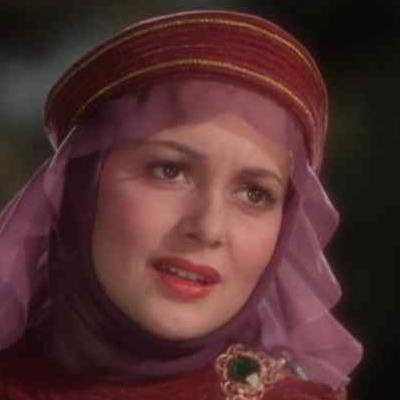
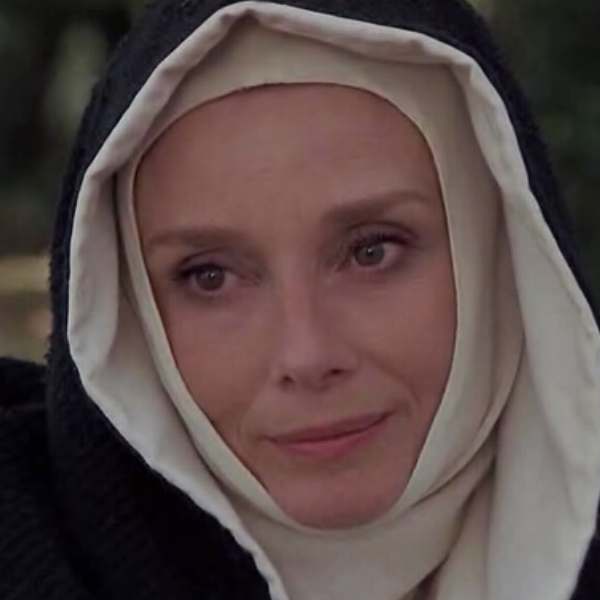

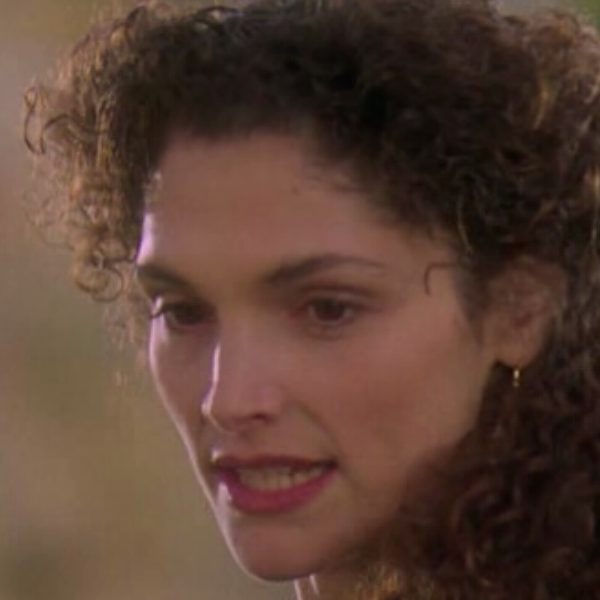

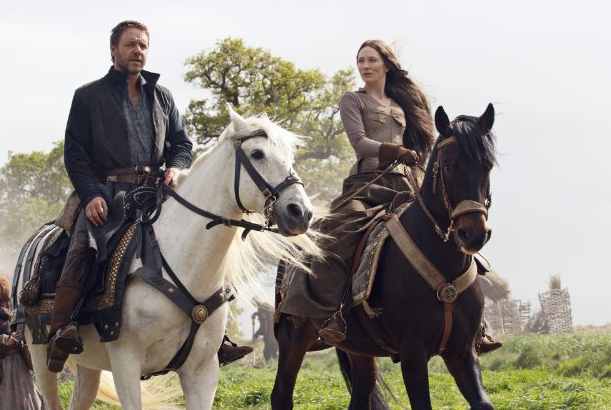
Manly, yes, but I like it, too.
Sunday May 09, 2010
Robin Hoods: How Grandiose are the Opening Title Cards?
1922 (The Douglas Fairbanks version)
“Medieval England—England in the Age of Faith. Her chronicles tells of warriors and statesmen, of royal Crusaders, of jousting knights. Her ballads sing of jolly friars, of troubadours, of gallant outlaws who roamed her mighty forests. History—in its ideal state—is a compound of legend and chronicle and from out both we offer you an impression of the Middle Ages – ”

1938 (The Errol Flynn version)
“In the year of our Lord 1191 when Richard, the Lion-Heart, set forth to drive the infidels from the Holy Land, he gave the Regency of his Kingdom to his trusted friend, Longchamps, instead of to his treacherous brother, Prince John. Bitterly resentful, John hoped for some disaster to befall Richard so that he, with the help of the Norman baron, might seize the throne for himself. And then on a luckless day for the Saxons...”

1991 (The Kevin Costner version)
“800 years ago, Richard “The Lionheart,” King of England, led the third Great Crusade to reclaim the Holy Land from the Turks. Most of the young English noblemen who flocked to his banner never returned home.”
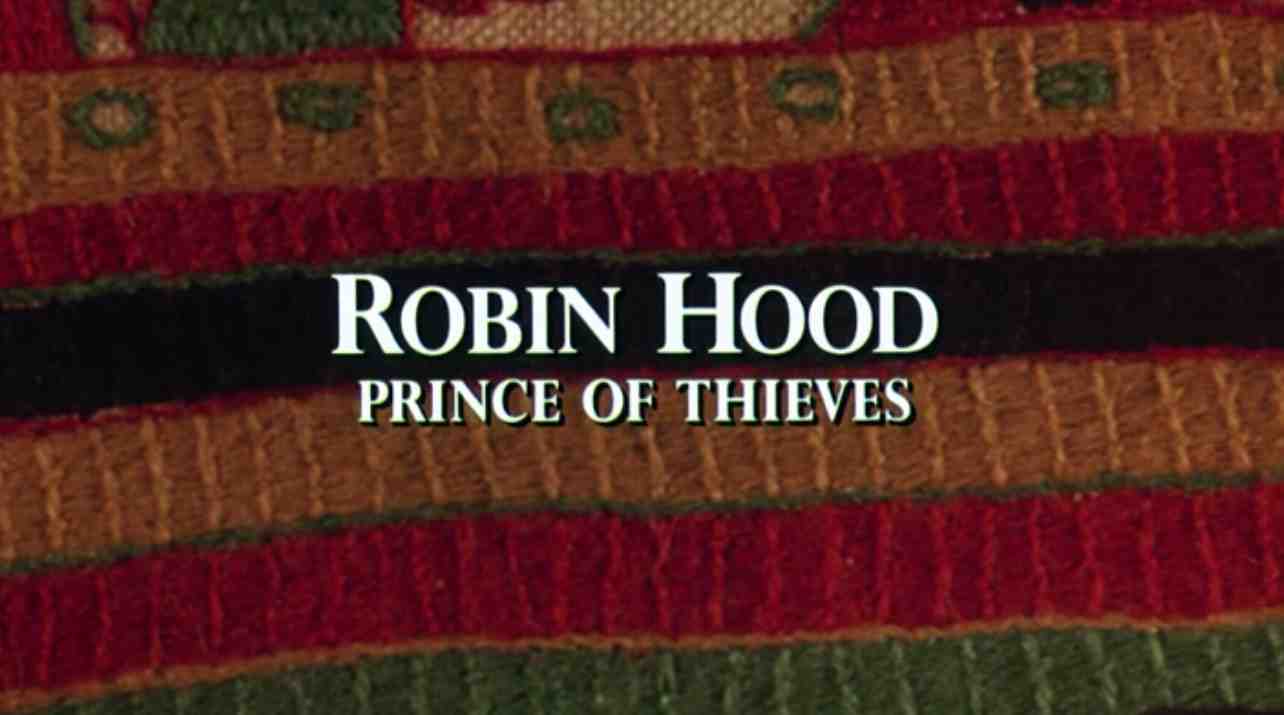
All previous entries
Baseball's Active Leaders, 2023
What Trump Said When About COVID
Recent Reviews
Everything Everywhere All at Once (2022)
Black Panther: Wakanda Forever (2022)
Doctor Strange in the Multiverse of Madness (2022)
Spider-Man: No Way Home (2021)
The Cagneys
A Midsummer Night's Dream (1935)
Something to Sing About (1937)
Angels with Dirty Faces (1938)
A Lion Is In the Streets (1953)
Man of a Thousand Faces (1957)
Never Steal Anything Small (1959)
Shake Hands With the Devil (1959)







